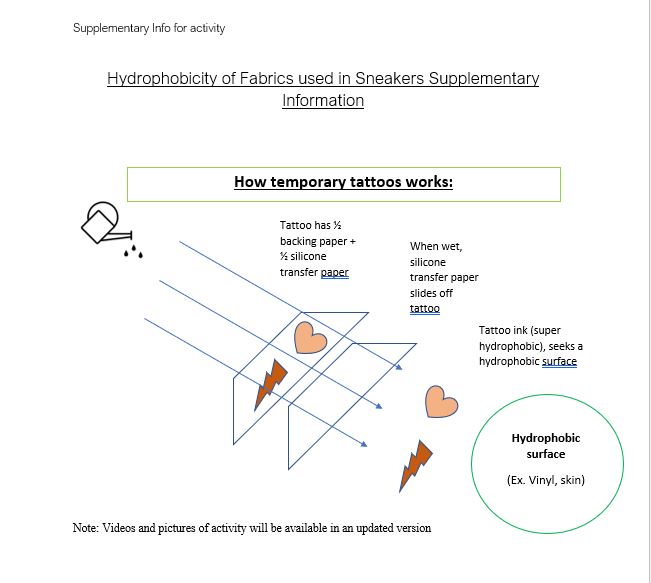12 My work: Supplementary info for hydrophobicity activity
Hydrophobicity of Fabrics used in Sneakers Supplementary Information
|
Directions for hydrophobic materials activity (Vinyl vs. Cotton)
|

| Definitions: | Connection to activity: |
| Hydrophobicity: The relationship between a material/surface and water | The hydrophobicity of the two materials vinyl and cotton will allow students to distinguish them. |
| Hydrophilic: “hydro-” (water) and “-phile” (love)
A surface that has a high affinity to water or is easily wet by water |
Hydrophilic materials, such as cotton rounds, will absorb the water (pores also are variable). Sneakers that are canvas material are mainly composed of cotton fibers (Ex. Vans, Converse). These shoes are not waterproof. |
| Hydrophobic: “hydro-” (water) and “-phobia” (fear)
Used to describe a surface with low affinity to water or repel water |
Materials such as vinyl, leather, and suedes are extremely hydrophobic and will repel water. Sneakers that are made with these materials are classified as “waterproof” (Ex. Nike, FILA, HOKA) |
| Polymer: any of a class of natural or synthetic substances composed of very large molecules, called macromolecules, that are multiples of simpler chemical units called monomers | The polymers used in the ink for the tattoos are hydrophobic. When released from silicone transfer paper, this migrates toward the hydrophobic surface of the vinyl. |
| Water: Water is a chemical compound consisting of two hydrogen atoms and one oxygen atom | Water is used as an indicator to measure how hydrophobic and/or hydrophilic a coated surface is. |
Note: Videos and pictures of activity will be available in an updated version

